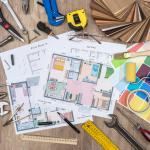Thanks to the power of video calls, we can “show up” at work as never before.
No more waiting to schedule a meeting once everyone’s back at the office.
No more trying to get everything across on a phone call, where you can’t show a document or slide deck to offer the team more context.
No more missing the visual and emotional cues that come from seeing other people’s faces.
Although the technology has been available for many years, it took the pandemic to make video calls a regular part of everyday life. Now, however, companies of every size have added another tool that – much like laptops and smartphones – can transform almost any environment into a workspace.
The tricky part is that it’s not just your head that appears on screen.
Sometimes your home office might be strewn with children’s toys, or not as tidy as you’d like it to be.
If you don’t have a designated space, your “office” might even be a kitchen table – complete with last night’s dirty dishes in the background.
Then there’s the fact that many homes have chandeliers that cast light in ways that look strange on a video call. Windows might create shadows.
Now throw in all the sounds, from traffic to possible construction going on nearby, that could impair the audio quality of your video calls.
The truth is, most of us probably didn’t set up our homes – or even a home office – with the notion we’d be spending so much time talking via videoconferencing. This was the result of what seemed, at first, like a temporary pivot to working remotely.
Now is the time to take a step back and reassess how you present yourself and your surroundings from home, in a way that builds confidence with whoever you may be speaking to on camera.
1. Lighten Up
Professional photographers and filmmakers learned a long time ago that their subjects rarely come off well when shrouded in darkness, or with the light directly behind them. Instead, they often use specialized tools such as flashbulbs and white balances to ensure light comes at an ideal angle.
The rise of video calls means some equipment, such as ring lights, are now widely available and more affordable than ever. You don’t have to invest in one, however. You can use household lamps that are normally intended for task lighting and simply place them strategically, or temporarily remove the shade.
Just make sure you have one light source coming from somewhere behind your computer towards your face, and ideally another that comes at an angle on your left side. It’s easy to experiment with this by hosting a video call where you’re the only one on.
2. Invest In Ergonomics
There’s nothing wrong with using a kitchen island as your desk, but relying on a stool as a chair may find you slumping your shoulders without even realizing it. If your keyboard is placed too high or too low, you could look awkward as you’re typing comments in the chat on a video call.
Consider an office chair with proper lumbar support that can be adjusted higher or lower depending on where you’re having a call. A standing desk (or a laptop stand that can be converted for sitting or standing) could also ensure you’re well-positioned for any meeting.
3. Double Your Vision
Talking (virtually) face to face is only one aspect of videoconferencing. Many remote meetings now involve walking through a slide deck, collaborating on digital white boards, and even demonstrating how an application works. That may call for adding a second monitor to your existing setup.
Having another screen means you’ll avoid the awkward toggling back and forth between sharing your screen and keeping your eyes on the others in the meeting. It also means they won’t be seeing your furrowed brow or frustrated expression as you’re trying to find information in another application during the call.
4. Make Yourself Heard
Even if the area immediately outside your home office is relatively free of ambient noise, there may be other distracting sounds close by.
Many of us are not the only ones working remotely, for instance. Your partner or family members might be having video calls at the same time you do.
In an effort to strike a better work-life balance, you might have people in to assist with a renovation on your home, or a service technician to make repairs of some kind.
You never want unexpected noises to derail an important business discussion. Headphones or ear buds are a good way to make sure you can listen properly to everything that’s being said. If your computer’s microphone picks up a lot of background sound, you could think about using a lapel mic that rests comfortably on your shirt.
5. Clear The Clutter
Contrary to what you might have heard, you don’t have to join every videoconference while making sure you have a blank white wall behind you.
Some books, family photos and personal nick knacks can add some personality to your space without creating a bad impression.
Use this litmus test: many of us created a bit of a unique style when we were working primarily in a cubicle or office. As long as the items in your background at home wouldn’t look out of space in those spaces, you’re probably okay.
There are also plenty of virtual backgrounds you can easily add to create a more neutral space, and more businesses are creating their own that feature their company logo. Just remember to double-check your lighting so that you’re not vanishing in and out of the digital backdrop.
Finally, this is just another occasion to put your customers at the forefront of your mind. Whether you work in sales, marketing or some other function, most of our video calls aren’t limited to chats with internal stakeholders.
You should create a home office environment that makes customers feel welcome, respected, and that represents the standards your business has set. If they’re more focused on what you’re saying than how you look on camera, chances are you’ve set yourself up well.

























